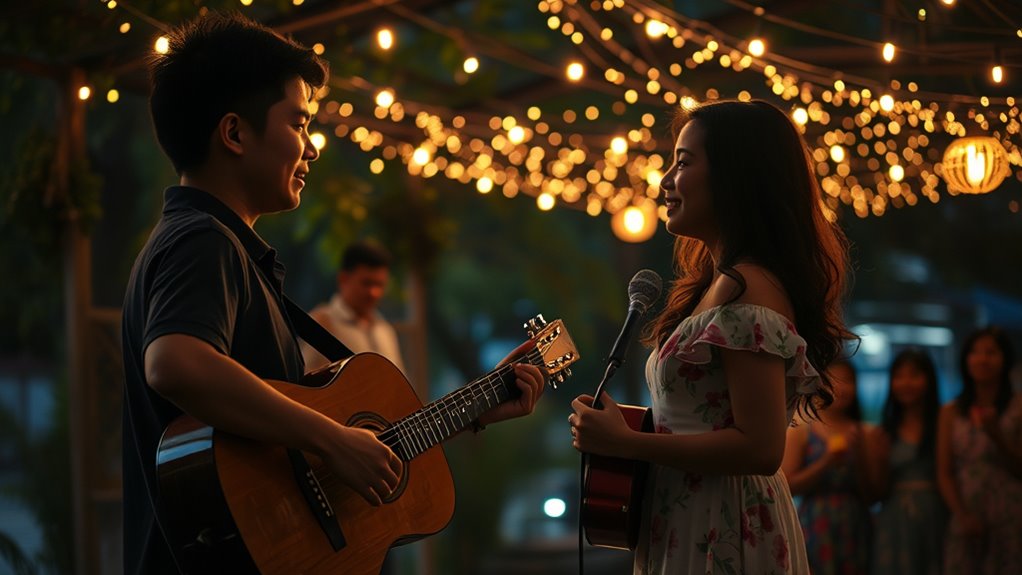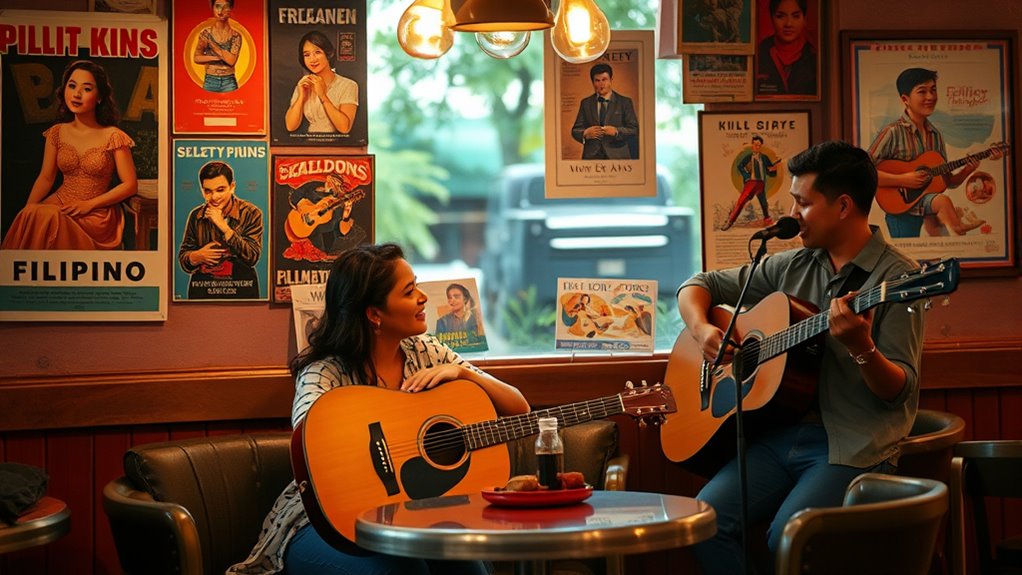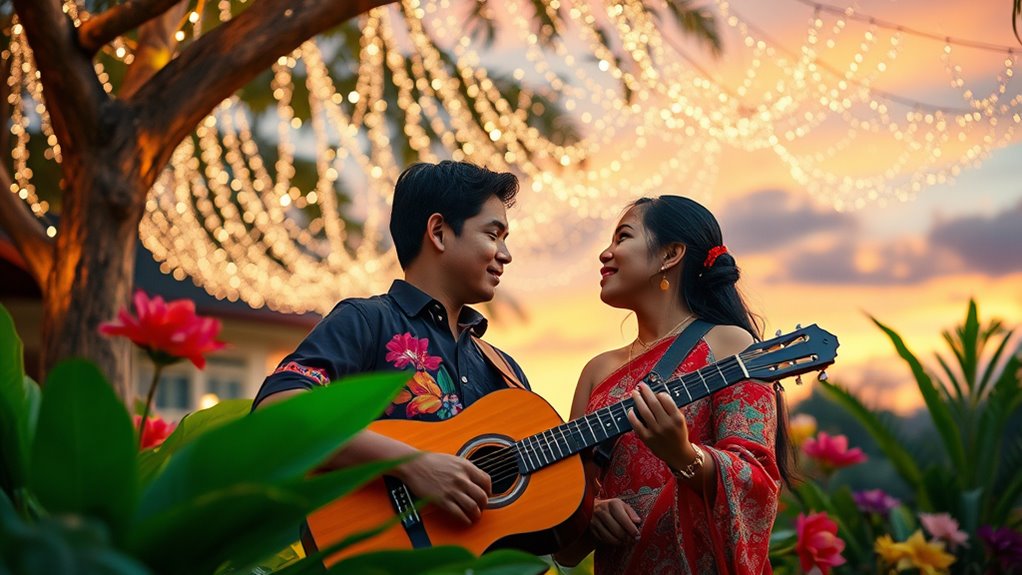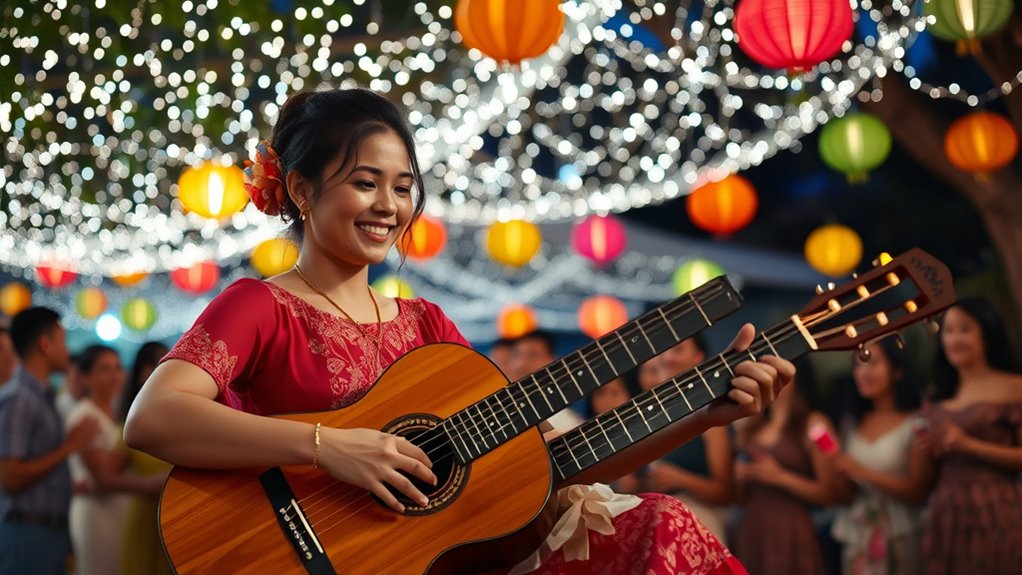Music’s got a vital place in Filipina dating romance. It helps you express emotions and fosters deep connections. Traditional songs like kundiman and harana reflect cultural values, enriching courtship practices. Modern Filipino music further evolves these expressions, blending old and new styles. Technology makes love songs more accessible, while iconic tracks shape your romantic experiences. If you explore further, you’ll find even more about how music influences love and relationships in the Filipino context.
Key Takeaways
- Traditional music forms like kundiman and harana enhance romantic expressions, evoking deep emotions and cultural sentiments in Filipina dating.
- Serenading through harana fosters sincerity and respect, creating memorable moments that celebrate love and familial involvement.
- Modern Filipino music blends traditional elements with contemporary styles, reshaping romantic connections and reflecting evolving social norms.
- Music facilitates emotional expression and connection, reinforcing intimacy between couples through shared experiences and nostalgic melodies.
- Community involvement in romantic practices emphasizes family values, ensuring transparency and respect during the courtship process.
The Essence of Kundiman: A Timeless Love Language

The beauty of Kundiman lies in its ability to convey profound emotions through music and poetry, making it a timeless love language in Filipino culture.
Kundiman beautifully expresses deep emotions through music and poetry, serving as a timeless love language in Filipino culture.
Originating in the early 19th century, Kundiman evolved into sophisticated art songs by the 20th century, blending Filipino folk elements with Western influences. Composers like Francisco Santiago and Nicanor Abelardo played an essential role in formalizing this genre, enriching its emotional depth.
You’ll find that Kundiman reflects love, longing, and even patriotism, resonating deeply within the Filipino heart. These songs, primarily in Tagalog, harness poetic verses to express sentiment.
As you listen, you’ll experience the cultural identity and national pride that this beautiful music artfully conveys, making Kundiman an enduring expression of love.
Harana: The Serenading Tradition of Courtship

Harana, a beautiful serenading tradition, captures the essence of Filipino courtship through heartfelt music and romantic gestures. Originating from Spanish serenatas, it evolved to showcase unique Filipino customs.
Typically performed at night, you’d stand outside the woman’s window, singing kundiman love songs like “O Ilaw” and “Dahil Sa Iyo.” This respectful act emphasizes admiration and involves her family, highlighting community values.
The sweet habanera rhythms and sincere lyrics express longing and humility, making your intentions clear. Friends often accompany you, enhancing the serenade’s charm.
While harana may be fading in modern times, its nostalgic significance remains, reminding us of genuine romance and the cultural importance of respectful courtship.
Emotional Expression Through Music

Music serves as a powerful medium for emotional expression, especially in Filipino culture, where heartfelt melodies resonate deeply with listeners.
Traditional Kundiman songs evoke intense feelings of love and longing, making them essential for conveying emotions in relationships. The poetic metaphors in Kundiman lyrics enhance this emotional impact, connecting you to universal themes of heartache and affection.
Kundiman songs encapsulate profound emotions of love and longing, using poetic metaphors to resonate with universal heartache and affection.
With its 3/4 time signature creating a flowing rhythm, Kundiman invites you to experience emotional depth. Additionally, the cultural significance of these songs fosters a sense of shared identity and authenticity in romantic expressions.
As you immerse yourself in this music, you’ll find it not only communicates complex feelings but also offers emotional support, reinforcing connections within your relationships. Understanding the meanings behind angel numbers can also enhance emotional connections, as they provide insights into the dynamics of love and relationships.
The Influence of Modern Filipino Music on Romance

As you explore emotional expression in Filipino dating, you’ll notice how modern Filipino music reshapes romantic connections.
This vibrant music scene blends traditional practices like harana with contemporary styles, creating unique expressions of love. Social media amplifies this influence, allowing artists to share fresh interpretations of romance widely.
You’ll find that modern lyrics embrace themes relevant to younger generations, reflecting evolving social norms and shifting gender roles. The fusion of genres—OPM, pop, rock, and R&B—offers a diverse soundscape for romance, ensuring accessibility across ages.
Despite these modern influences, traditional elements remain integral, preserving cultural identity while adapting to contemporary tastes. In this way, modern Filipino music greatly impacts how people experience and express love.
Cultural Values Reflected in Courtship Songs

While maneuvering through the rich tapestry of Filipino courtship, you’ll find that courtship songs profoundly reflect cultural values and traditions. The historical roots of these songs, blending indigenous and Spanish influences, shape your understanding of Filipino identity.
Traditional love songs like kundiman express deep emotions, allowing you to experience the essence of romanticism. When you listen to harana, you notice how it emphasizes respect and unity, involving families and communities in the process.
The soulful melodies and poetic lyrics create an emotional depth that captures longing and admiration. By embracing these traditional values, you engage with a cultural legacy that highlights humility and genuine affection, making your romantic experiences more meaningful and connected to your heritage.
Community Involvement in Romantic Practices

Community involvement is a cornerstone of romantic practices in Filipino culture, shaping how relationships develop and flourish. In traditional courtship, family members play an essential role, ensuring transparency and respect.
Practices like _pagliligawan sa bahay_ emphasize family interaction, fostering a strong sense of community. Acts of service, such as _paninilbihan_, allow you to demonstrate character and commitment, as 67% of Filipinos express love through these gestures.
The public nature of courtship, including serenades like _harana_, invites community witnesses, reinforcing respect and validation. Ultimately, the community’s approval and expectations shape romantic relationships, deeply ingrained in cultural norms, ensuring that love isn’t just personal but a shared experience.
The Evolution of Courtship: Blending Old and New

The evolution of courtship in the Philippines reflects a fascinating blend of traditional practices and modern influences, allowing you to witness how cultural values adapt over time.
Traditional methods like *panliligaw* and *pamamanhikan* emphasized family involvement and patience, while playful teasing (*tuksuhan*) helped gauge mutual interest. The incorporation of trailer music techniques can similarly enhance the emotional depth of romantic gestures, drawing parallels between the two forms of expression. Music has always played a crucial role in Filipino culture, as it serves to convey feelings and connect people on a deeper level. Art theory can also inform how music is utilized in romantic expressions, allowing for a more nuanced understanding of emotional communication.
Serenades (*harana*) expressed emotions through music, showcasing sincerity and dedication. Additionally, recognizing soulmate angel numbers can enhance your romantic journey by signaling readiness for deep emotional connections.
As society evolves, so does courtship; modern elements like e-harana and dating apps create quicker connections. Digital love letters replace handwritten notes, merging old customs with new conveniences. The rise of technology has transformed communication, making it easier for couples to share their experiences and feelings through digital platforms.
This hybrid approach allows you to embrace both the rich heritage of Filipino courtship and the fast-paced world of today, creating a diverse and enriching romantic experience. Additionally, understanding smart shopping techniques can enhance your dating experience by helping you save while planning romantic outings or purchasing thoughtful gifts.
Technology’s Role in Spreading Filipino Love Songs

As technology advances, it plays an essential role in spreading Filipino love songs, making them more accessible than ever.
Now, you can easily find traditional harana songs on digital music platforms, where artists create new renditions blending classic melodies with contemporary styles. Streaming services simplify your search for Filipino love songs, letting you discover and enjoy them instantly.
Easily discover traditional harana songs reimagined with contemporary styles on digital music platforms, enhancing your love for Filipino melodies.
Social media platforms like TikTok and YouTube help these songs go viral, reaching a global audience. Plus, online music communities foster appreciation and discussions around these melodies.
With modern technology, artists collaborate internationally, producing innovative content that resonates with younger generations while preserving cultural heritage, ensuring that the beauty of Filipino love songs continues to thrive.
Iconic Love Songs and Their Impact on Relationships

Many people find that iconic love songs have a profound impact on their relationships, shaping how they express their feelings and connect with one another.
These timeless melodies, like Pilita Corrales’ “Dahil Sa Iyo” or Up Dharma Down’s “Tadhana,” evoke deep emotions and nostalgia, allowing you to articulate sentiments that might otherwise be hard to express.
They create shared experiences, wrapping couples in a romantic atmosphere that fosters intimacy. As you sing along or listen together, these songs strengthen your bond, connecting you through a rich cultural heritage.
Whether you’re experiencing love, heartache, or longing, these classic tracks resonate across generations, ensuring that love songs remain an essential part of your romantic journey.
Reviving Traditional Practices Through Music

While you may embrace modern dating practices, reviving traditional ones like harana can add a rich layer of meaning to your romantic experiences.
This beautiful Filipino courtship ritual involves serenading your beloved under the stars, using kundiman love songs to express longing and admiration. Harana emphasizes sincerity and respect, reflecting core Filipino values like humility and patience.
By incorporating this practice into your dating life, you not only showcase your dedication but also strengthen family bonds through community involvement.
Imagine gathering friends to support your serenade—it’s a heartwarming way to connect with your cultural heritage.
Reviving harana lets you create memorable moments that celebrate love, deep emotions, and the timeless beauty of Filipino tradition.
Frequently Asked Questions
How Do Modern Filipino Love Songs Differ From Traditional Kundiman?
Modern Filipino love songs differ from traditional Kundiman in various ways.
You’ll notice that modern songs explore a broader emotional range, often blending contemporary themes with traditional elements. The instrumentation has evolved, incorporating electronic sounds alongside acoustic ones.
Additionally, vocal styles reflect global trends, while production quality has improved greatly. Unlike Kundiman’s storytelling focus, modern tunes emphasize catchy hooks, making them more accessible to a global audience while still honoring cultural roots.
What Instruments Are Commonly Used in Traditional Filipino Courtship Music?
Imagine a garden of melodies blooming in traditional Filipino courtship, where instruments like the guitar strum love’s sweet serenade.
You’ll hear the kulintang, sending poetic messages, and the agong, resonating with passion.
The gandingan adds a touch of elegance, creating harmonious dialogues between suitors.
These instruments weave a tapestry of emotions, reflecting respect and admiration, as families gather to witness the beauty of love expressed through music and tradition.
Are There Regional Variations in Filipino Love Songs and Practices?
Yes, there are definitely regional variations in Filipino love songs and practices.
In Batangas, you might hear Kumintang, blending Spanish and indigenous melodies, while Tagalog’s Kundiman showcases soothing instrumentals and passionate vocals.
Visayan songs often reflect family themes and separation.
Each region’s dialect adds depth, making expressions of love unique.
You’ll notice how these variations capture the rich cultural heritage and emotional nuances of romance across the Philippines.
How Has Globalization Affected Filipino Romantic Music Styles?
Imagine a vibrant garden where traditional flowers bloom alongside exotic plants. Globalization’s influence on Filipino romantic music is like this garden.
You notice how diverse rhythms and styles intertwine, reshaping familiar melodies. Traditional sounds, once dominant, now compete with pop and global trends, altering your music experience.
As new genres flourish, you might find it harder to hear the whispers of classic harana, yet the fusion creates fresh expressions of love and connection.
What Role Do Lyrics Play in Expressing Emotions in Filipino Love Songs?
Lyrics play an essential role in expressing emotions in Filipino love songs. They connect you to the feelings of longing, joy, or heartache, resonating deeply within you.
Through storytelling and poetic language, the lyrics evoke vivid imagery, allowing you to relate to the sentiments expressed. Whether it’s a simple declaration of love or a complex tale of heartbreak, these lyrics capture the essence of your emotions, making the experience truly personal and unforgettable.
Conclusion
In exploring the rich tapestry of Filipina dating, it’s clear that music isn’t just an accessory; it’s an essential thread weaving connections and emotions. While some might argue that modern influences dilute tradition, the fusion of old and new actually enriches the romantic experience. By embracing both classic Kundiman and contemporary melodies, you’re not only honoring the past but also creating a unique narrative for your love story, one that resonates deeply with cultural significance and personal expression.









